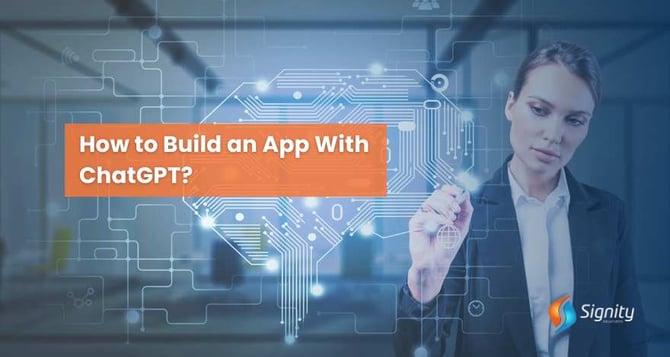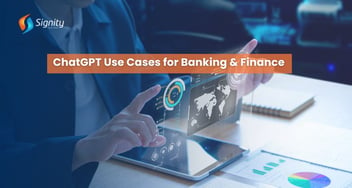How to Build an App With ChatGPT?
ChatGPT use cases are rising with its advancement day by day. From content generation to language translation and app development, this technology has disrupted the industries. Learn how to build an app with ChatGPT and the benefits that it can bring to your business.

Launched in 2022, ChatGPT has already gained 180.5 million monthly users and 100 million weekly active users. Are you aware of ChatGPT's full potential? From virtual assistants for business to language translation, content moderation, personalized content generation, and AI-powered chat agents, the applications of ChatGPT are vast.
But did you know that ChatGPT can also be used for building apps? ChatGPT integration can make the process of creating apps easy, time, and cost-efficient.
By the end of this blog, you will have a complete understanding of how ChatGPT can help you build apps.
Key Takeaways
- As ChatGPT eliminates the need for complicated model construction, app production is streamlined, saving time and money.
- Natural language interactions increase user satisfaction and loyalty by enhancing engagement.
- The flexibility of ChatGPT enhances the app's features, extending beyond help and Q&A.
- Development is sped up by pre-trained models and APIs, providing more time for feature refinement.
ChatGPT Integration for NLP-Based App Development
Natural language processing involves the use of algorithms to analyze and understand human language, enabling tasks like.
- Language Translation,
- Sentiment Analysis, and
- Chatbot Interactions.
It's a branch of AI focused on processing and interpreting natural language data.
With the help of NLP techniques, you can provide personalized responses and quickly adapt to user preferences. This whole process by NLP ensures better user engagement and satisfaction, bringing repeat sales for the business.
Read more here: What is Natural language processing?
Let us now understand how, with the help of ChatGPT integration, you can build an app for your business.
How to Build an App With ChatGPT?
To explain the process better, we will take an example of building a customer support app entirely with the help of ChatGPT for Android. No matter what industry your business belongs to, you will always need a robust customer support system that can quickly provide the perfect solutions.
Quality customer support services have become so important as 88% of customers are willing to purchase again from a company that provides good customer service.
Below are the steps to follow when building a customer support app for your business. Before you begin building the app, you must define the target audience and user personas for your app. It will enable you to understand in detail the app's functionality, features, and user interface.
1. Define the Use Case
Defining the use case is a crucial step in the process of building an app with ChatGPT. It includes the app's purpose, features, scope, scalability, privacy, and security. Now, when you are creating a customer support app, the use cases can defined as below:
Purpose: The purpose of your app can be to provide assistance and resolution to users' queries and issues through natural language interactions. It means that your customers should be able to communicate with the app using their everyday language.
Features: Another important factor is the features and functionalities of the customer support app. With the help of it, users will be able to get the perfect solution to their queries and complaints.
Some of the important features that you must add to the customer app are:
- Ticket management
- Live chat support
- Knowledge base
- Customer feedback and survey tools
- Issue reporting
- Natural language understanding
- Self-service options
2. Choose an Integration Approach
Deciding on how to integrate ChatGPT into your customer support app is part of the "Choose an Integration Approach" process. You have two options: you may integrate the ChatGPT model directly into your app's front or backend. Alternatively, you can utilize OpenAI's hosted API, which allows your app to submit text inputs to OpenAI's servers for processing.
Because OpenAI handles the infrastructure and updates, using its hosted API is convenient and scalable. However, transmitting user data to OpenAI's servers may result in fees depending on use.
3. Add Open API Dependency
We are going to add the OpenAI API requirement to your Android project in this phase. This requirement makes it possible for your app to communicate with the OpenAI API, which is required in order to send and receive user messages to the GPT model.
To add the OpenAI API dependency, you need to modify your app's build.gradle file, which is typically found in the "app" module of your Android project.
4. Initialize OpenAI API
You must set up the OpenAI API using your API key in order to initialize it in your Android application. It typically includes passing your API key as an argument when implementing the OpenAI.configure() function.
Usually, your Application class's onCreate() function or another suitable initialization class handles this initialization phase. You may make sure that your application is authenticated to communicate with the OpenAI services throughout its lifespan and send and receive requests from the GPT model by setting the OpenAI API with your API key.
5. Create Chat Activity Layout
Consider using elements like EditText for user input, a Button for sending messages, and a TextView or RecyclerView to show the conversation history when creating the layout for your Android app's chat activity.
To specify how these elements will be arranged and shown in your activity:
- Use XML layout files.
- Make sure the layout makes sense, is aesthetically pleasing, and complements the branding of your app.
- Adjust properties like font, color, size, and location to produce a unified user interface.
<LinearLayout xmlns:android="http://schemas.android.com/apk/res/android" android:layout_width="match_parent" android:layout_height="match_parent" android:orientation="vertical"> <ScrollView android:layout_width="match_parent" android:layout_height="0dp" android:layout_weight="1"> <TextView android:id="@+id/chatTextView" android:layout_width="match_parent" android:layout_height="wrap_content" android:textColor="@android:color/black" android:textSize="16sp" android:padding="8dp" /> </ScrollView> <LinearLayout android:layout_width="match_parent" android:layout_height="wrap_content" android:orientation="horizontal"> <EditText android:id="@+id/userInputEditText" android:layout_width="0dp" android:layout_height="wrap_content" android:layout_weight="1" android:hint="Type your message here" android:inputType="text" /> <Button android:id="@+id/sendButton" android:layout_width="wrap_content" android:layout_height="wrap_content" android:text="Send" /> </LinearLayout></LinearLayout> |
6. Implement Chat Functionality
In the "Implement Chat Functionality" step, you will develop code to manage user message transmission to the GPT model and response display. In order to do this, methods for sending user inputs to the OpenAI API for processing must be created. The resultant replies must then be updated in the user interface.
import com.openai.api.models.CompletionRequest;import com.openai.api.models.CompletionResponse;public class ChatActivity extends AppCompatActivity { private EditText userInputEditText; private TextView chatTextView; @Override protected void onCreate(Bundle savedInstanceState) { super.onCreate(savedInstanceState); setContentView(R.layout.activity_chat); userInputEditText = findViewById(R.id.userInputEditText); chatTextView = findViewById(R.id.chatTextView); // Handle send button click findViewById(R.id.sendButton).setOnClickListener(new View.OnClickListener() { @Override public void onClick(View v) { String userInput = userInputEditText.getText().toString().trim(); if (!TextUtils.isEmpty(userInput)) { sendMessage(userInput); userInputEditText.setText(""); } } }); } private void sendMessage(String message) { // Call OpenAI API to get response new Thread(new Runnable() { @Override public void run() { try { CompletionRequest completionRequest = new CompletionRequest.Builder() .prompt(message) .maxTokens(150) .build(); CompletionResponse completionResponse = OpenAI.complete(completionRequest); // Update UI with response runOnUiThread(new Runnable() { @Override public void run() { displayMessage(completionResponse.getChoices().get(0).getText()); } }); } catch (Exception e) { e.printStackTrace(); } } }).start(); } private void displayMessage(String message) { // Display response in chat interface chatTextView.append("ChatGPT: " + message + "\n"); }} |
7. Handle Errors and Edge Cases
Implement robust error handling mechanisms to gracefully manage unexpected scenarios and edge cases, ensuring uninterrupted user interaction and a seamless customer support experience.
8. Test and Iterate
Evaluate the app's functioning in-depth during the "Test and Iterate" phase by modeling various support situations, getting user input, and continually improving the features and answers of the app based on insights gathered. By matching the software with user expectations and enhancing overall user pleasure, this iterative method promotes continuous enhancement.
9. Deploy Your App
Once your software is working properly, release it via alternate distribution methods like the Google Play Store. Verify that the application satisfies every requirement and deployment standard. After implementation, track user input and quickly resolve any problems to ensure the best possible user experience.
Benefits of Using ChatGPT for App Development
Using ChatGPT to build apps for your business can help you in several ways. From saving plenty of time to lowering costs, zero coding, and more, this generative AI can do wonders.
Here are some of the biggest advantages of building an app with the help of ChatGPT:
-
Enhanced User Experience
By Enabling natural and conversational interactions with ChatGPT integration, power up conversational experience and increase satisfaction and engagement. Users can communicate more easily because of its natural language understanding features, which also make the software more dynamic and customized.
-
Versatile Functionality
With its flexible features, ChatGPT can perform a wide range of functions, including answering questions, making suggestions, and giving support—all of which greatly expand the app's potential. It is an effective tool for increasing app functionality and enhancing user engagement because of its versatility in many use scenarios.
-
Reduced Development Time and Effort
By removing the requirement for developers to build and train complex language models from scratch, ChatGPT integration dramatically cuts down on the time and effort needed to develop apps. This procedure speeds up the development time and boosts overall efficiency by allowing developers to concentrate more on refining user experience.
-
Improved User Engagement
By enabling natural language conversations, ChatGPT integration into app development fosters a more customized and engaging experience that increases user engagement. It also leads to better user participation and happiness, hence increasing app retention and royalty.
-
Streamlined Development Processes
By using ChatGPT's pre-trained models and APIs, app development can be streamlined to save development costs and accelerate time to market. By making use of these resources, developers can reduce the amount of time and money they must spend training models, freeing up more time to concentrate on improving user experience and app features. It eventually results in development cycles that are more productive and economical.
ChatGPT Integration for App Development is the Future
The capabilities of ChatGPT for app development are expansive and provide enhanced user experience and versatile functionalities, as well as reduce development time and effort to a large extent.
Using this for your business app development will not only simplify the creation process but will also skyrocket user satisfaction and engagement. With the help of ChatGPT development services at Signity, you can get the best solutions at a reasonable price.
Our ChatGPT developers are trained to design applications for businesses across all industries by using the latest technologies and practices. Connect with us to discuss the app idea.
Frequently Asked Questions
Have a question in mind? We are here to answer. If you don’t see your question here, drop us a line at our contact page.
Can I use ChatGPT to create an app?
![]()
Yes, you can use ChatGPT to build an application. To allow chatbot capabilities and natural language conversations, integrate the OpenAI API into your application.
How do I create an application using ChatGPT API?
![]()
To create an application using ChatGPT API, you'll need to
- sign up for API access from OpenAI,
- integrate the API into your codebase, and then
- implement the necessary logic to handle user inputs and respond to queries using the ChatGPT model.
How do I create a GPT app?
![]()
Steps to create a GPT app include getting access to OpenAI's GPT API, integrating it into the program, and developing the features required.
Can you code with ChatGPT?
![]()
Can ChatGPT make an Android app?
![]()


%201-1.webp)


.png?width=344&height=101&name=Mask%20group%20(5).png)

.png?width=1200&height=250&name=Top%20Industries%20That%20Could%20Benefit%20from%20ChatGPT%20(1).png)
















